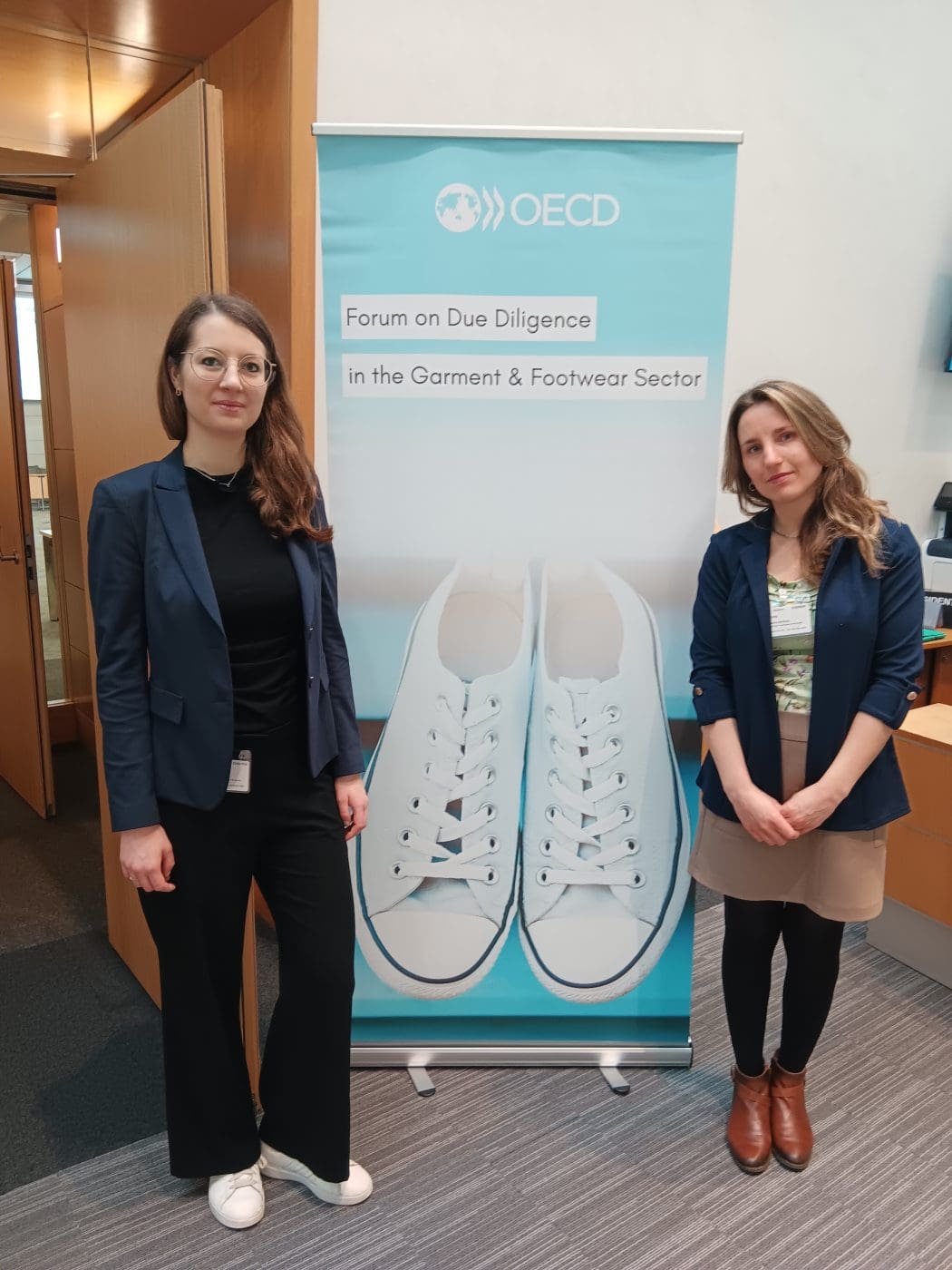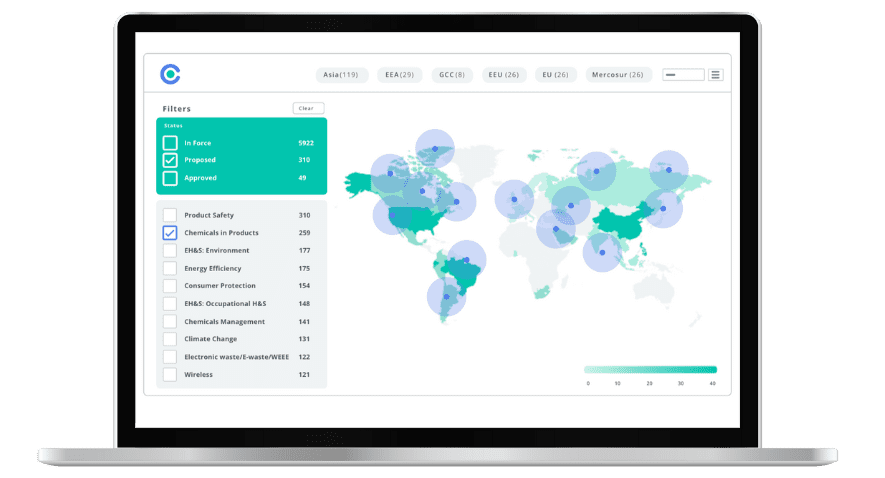
6 Key Takeaways from the OECD Forum on Due Diligence in the Garment and Footwear Sector 2024

This blog was originally posted on 26th February, 2024. Further regulatory developments may have occurred after publication. To keep up-to-date with the latest compliance news, sign up to our newsletter.
AUTHORED BY CELIA LE LIEVRE, SENIOR REGULATORY COMPLIANCE SPECIALIST, AND HANNAH JANKNECHT, REGULATORY COMPLIANCE SPECIALIST, COMPLIANCE & RISKS
Introduction
The 10th OECD Forum on Due Diligence in the Garment and Footwear Sector was held in Paris on 21-22 February 2024. Compliance & Risks was represented at the Forum by regulatory compliance specialist Hannah Janknecht and senior regulatory compliance specialist Celia le Lievre. Over two days, the forum brought together representatives of government, businesses, trade union and civil society to review progress on the implementation of the OECD Due Diligence Guidance for Responsible Supply Chains in the Garment and Footwear Sector.
While it is not easy to pick from the vast amount of topics discussed at the forum, we want to share a few overarching themes that were brought up throughout the conference and that are likely to play a key role in coming years.
1. The Complexity of Regulatory Developments
The conference kicked off with discussions on binding union agreements which also addressed the elephant in the room, namely, the long-negotiated and currently struggling EU Corporate Sustainability Due Diligence Directive (CSDDD). Panel speaker Bärbel Kofler, state secretary of the German Federal Ministry of Economic Cooperation and Development, found clear words to underline her Ministry’s continuing support for the finalization of the CSDDD and expressed her disappointment in the pullback by her coalition partner, the German Liberal Party. Dr. Kofler furthermore drew a positive comparison with the German Supply Chain Due Diligence Act which, after its first year, received very positive feedback from trade unions particularly with regard to the newly introduced network of help desks for suppliers.
Although the main focus of the Forum was on due diligence, many of the panels naturally touched upon other regulations that are currently emerging in the garment sector, leading to one panelist noting that the fashion industry is becoming a ‘regulated sector’. This included proposed and introduced legislation on extended producer responsibility for textiles, recycling processes and the importance of reducing and managing the use of chemicals.
2. Living Wage vs Minimum Wage
The forum saw an especially heated debate on the long-standing issue around the payment of a living wage. The speakers discussed the often existing gap between the minimum wage and the living wage and listed a number of approaches that brands can follow to remedy the situation, including building long-term relationships with suppliers, supporting the formation of trade unions and framing the payment of a living wage as a positive business case. Several members of the audience however remarked that the issue of a living wage has been discussed at many conferences before without being followed by real changes in practice. Furthermore, a member of the audience questioned whether the debate around the difference between the minimum and living wage might simply serve as a way to push out action, since in many cases payments lack far behind the minimum wage to begin with.
3. Highlighting the Opportunities in Due Diligence
Another aspect discussed across different panels was the need to highlight not only the challenges but also the opportunities that due diligence can bring for brands and suppliers. A representative from the Joint Apparel Association Forum Sri Lanka took the opportunity to explain how Sri Lanka adopted its own standards for sustainable fashion as a way to compete with larger manufacturing countries such as India and Bangladesh. The use of such standards can help brands to retain existing customers, improve their overall reputation and identify risks in the supply chains at an early stage. Another speaker underlined the need to take a similar approach with regard to trade unions and the freedom of association. While these are often seen as a sign for problems, brands need to start considering them as a way to step into dialogue with the workers themselves and a tool to look beyond mere auditing processes.
4. Looking Beyond Audits: the Limits of Certification in Human Rights Due Diligence
This panel discussed the opportunities and limitations for companies using certifications as part of their own human rights due diligence process. Key motivating factors for obtaining certification in the context of human rights due diligence include the need to meet the growing customer demand for responsible products and ensuring compliance with regulations/standards.
Certification is not a panacea and should not be perceived as a substitute for conducting internal due diligence. In its report on Audit Deception, Tranparentum compiled evidence of poor social auditing practices in the apparel supply chains in India, Malaysia and Myanmar. Audits generally offer a snapshot of one day in the operation of a factory. The short timeframe gives managers the opportunity to instruct and exercise pressure on the workforce to create an “illusion” of compliance. In addition, social auditors are not legally liable for failure to detect abuses, hazardous conditions or inaccurate reporting. Moreover, when paid by factories, auditors may be inclined to ignore certain issues on the factory floor to secure future contracts with their clients. Audits require structural changes to effectively tackle human rights issues in company supply chains:
- Unannounced audits should be prioritized to accurately assess working conditions;
- Audits should incorporate age-verification techniques to prevent factories from concealing underaged workers or falsifying identity documents;
- Auditors should be independent bodies regulated by the government and face legal consequences for failure to detect abuses and hazardous conditions;
- Audit reports must be publicly disclosed to give NGOs and trade unions an opportunity to review their accuracy.
In short, it is important for companies to understand the limitations of social auditing to fulfill their due human rights diligence obligations. The key message is that buyers should go “beyond auditing” by building long-term relationships with their suppliers based on trusts and shared human rights values. Such relationships will incentivise suppliers to improve working conditions in the factory. Through sustained supplier relationships, buyers should take an active role in ensuring that workers have access to adequate representation, freedom of association and human rights training. Buyers should also provide financial support to encourage their suppliers to develop effective human rights programs.
5. Access to Remedies and Grievance Mechanisms
This session explored workers’ experiences of accessing remedy when filing complaints under existing judicial and non-judicial mechanisms in the garment and footwear sector. The panel comprised speakers from International Accords, the Fair Wear Foundation, the OECD NCPs for RBC, the European Centre for Constitutional and Human Rights and Glasen Tekstilec.
These non-profit organizations operate grievance mechanisms (GM) for workers in the textile and footwear industry. GMs aim to ensure that companies remediate the human right impacts they have caused or contributed to through inter alia, restitution, rehabilitation, financial or non-financial compensation, and/or punitive sanctions.
Effective GMs are key tools to successful human rights due diligence. The panelists outlined the main criteria for fair and accessible GMs, as partly defined by the OECD Guidelines for Multinational Enterprises and the UN Guiding Principles on Business and Human Rights (UNGPs):
- Accessibility: GMs must be known to all stakeholders that they are intended for, and provide non-onerous information regarding their existence; access barriers regarding language, literacy, costs, physical location and fear of reprisal must be overcome through local assistance;
- Accountability: workers must be able to trust the process and be actively involved in the remediation process;
- Predictability: a clear and known procedure with an indicative time frame for each stage and clarity on the types of process and outcomes must be available;
- Equitability: it must be ensured that aggrieved parties have reasonable access to information and expertise to engage in a GM “on fair, informed and respectful terms”;
- Protection against retaliation is essential to ensure workers use GMs in practice; the identity of the employee must be kept anonymous. Where not possible, the consent of the employee must be obtained prior to revealing his/her identity;
- Transparency: GMs must keep parties informed about their progress, and prove sufficient information about the mechanism’s performance;
- Independent trade unions: provide a point of access, and represent and act on behalf of complainants;
- Role of Governments: Governments must also take appropriate steps to ensure that those affected have access to effective remedy in their jurisdiction. For example, the German Supply Chain Due Diligence Act requires companies to establish complaint mechanisms from 1 January 2023;
- Binding decisions on companies: the outcome of the remedy process must be enforceable on companies.
6. Supply Chain vs Value Chain: Improving Circular Processes
As part of the panel on circular processes, the forum discussed the importance of extending due diligence to the ‘afterlife’ of the garment. With the rise of new waste management requirements such as extended producer responsibility for textiles and the use of recycled materials, it is crucial for companies to take a holistic approach and look at the broader concept of due diligence in the value chain. While recycling of garments is widely promoted as a way to make the industry more circular, there are large information gaps in the supply chain of recycled materials. Discarded textiles often go through the hands of several waste management companies before reaching their final recycling destination, which makes tracking their origin, identifying materials and sorting extremely difficult. Several panel members therefore underlined the importance of careful supply chain mapping also for recycled materials and advocated for the sorting of textiles in their country of origin before shipping them to the recyclers location.

Stay Ahead Of Regulatory Changes
Accelerate your ability to achieve, maintain & expand market access for all products in global markets with C2P – Your key to unlocking market access, trusted by more than 300 of the world’s leading brands.
C2P is an enterprise SaaS platform providing everything you need in one place to achieve your business objectives by proving compliance in over 195 countries.
C2P is purpose-built to be tailored to your specific needs with comprehensive capabilities that enable enterprise-wide management of regulations, standards, requirements and evidence.
Add-on packages help accelerate market access through use-case-specific solutions, global regulatory content, a global team of subject matter experts and professional services.
- Accelerate time-to-market for products
- Reduce non-compliance risks that impact your ability to meet business goals and cause reputational damage
- Enable business continuity by digitizing your compliance process and building corporate memory
- Improve efficiency and enable your team to focus on business critical initiatives rather than manual tasks
- Save time with access to Compliance & Risks’ extensive Knowledge Partner network

ESG 2023: A Year in Review
Our whitepaper summarizes the ESG regulatory landscape in 2023, reviewing the key regulations proposed, published and/or entered into force.



